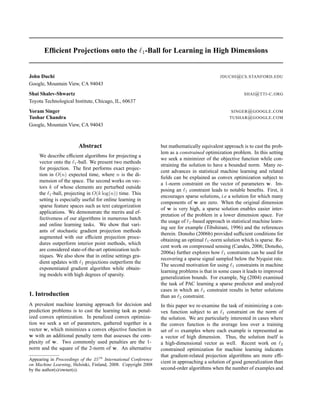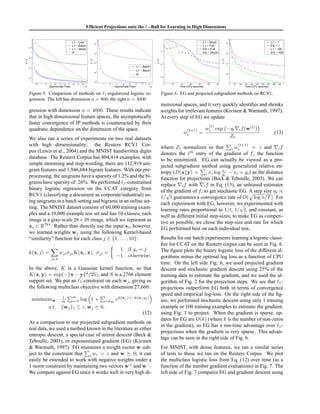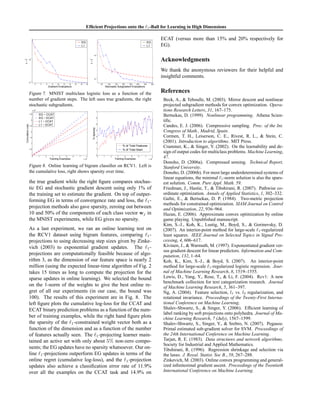The document describes efficient algorithms for projecting a vector onto the l1-ball (sum of absolute values being less than a threshold). It presents two methods: 1) An exact projection algorithm that runs in expected O(n) time, where n is the dimension. 2) A method for vectors with k perturbed elements outside the l1-ball, which projects in O(k log n) time. It demonstrates these algorithms outperform interior point methods on various learning tasks, providing models with high sparsity.

![Efficient Projections onto the ℓ1-Ball for Learning in High Dimensions
the dimension are large. For instance, Shalev-Shwartz
et al. (2007) give recent state-of-the-art methods for solv-
ing large scale support vector machines. Adapting these
recent results to projection methods onto the ℓ1 ball poses
algorithmic challenges. While projections onto ℓ2 balls are
straightforward to implement in linear time with the ap-
propriate data structures, projection onto an ℓ1 ball is a
more involved task. The main contribution of this paper is
the derivation of gradient projections with ℓ1 domain con-
straints that can be performed almost as fast as gradient
projection with ℓ2 constraints.
Our starting point is an efficient method for projection onto
the probabilistic simplex. The basic idea is to show that,
after sorting the vector we need to project, it is possible to
calculate the projection exactly in linear time. This idea
was rediscovered multiple times. It was first described in
an abstract and somewhat opaque form in the work of Gafni
and Bertsekas (1984) and Bertsekas (1999). Crammer and
Singer (2002) rediscovered a similar projection algorithm
as a tool for solving the dual of multiclass SVM. Hazan
(2006) essentially reuses the same algorithm in the con-
text of online convex programming. Our starting point is
another derivation of Euclidean projection onto the sim-
plex that paves the way to a few generalizations. First we
show that the same technique can also be used for project-
ing onto the ℓ1-ball. This algorithm is based on sorting the
components of the vector to be projected and thus requires
O(n log(n)) time. We next present an improvement of the
algorithm that replaces sorting with a procedure resembling
median-search whose expected time complexity is O(n).
In many applications, however, the dimension of the feature
space is very high yet the number of features which attain
non-zero values for an example may be very small. For in-
stance, in our experiments with text classification in Sec. 7,
the dimension is two million (the bigram dictionary size)
while each example has on average one-thousand non-zero
features (the number of unique tokens in a document). Ap-
plications where the dimensionality is high yet the number
of “on” features in each example is small render our second
algorithm useless in some cases. We therefore shift gears
and describe a more complex algorithm that employs red-
black trees to obtain a linear dependence on the number
of non-zero features in an example and only logarithmic
dependence on the full dimension. The key to our con-
struction lies in the fact that we project vectors that are the
sum of a vector in the ℓ1-ball and a sparse vector—they are
“almost” in the ℓ1-ball.
In conclusion to the paper we present experimental results
that demonstrate the merits of our algorithms. We compare
our algorithms with several specialized interior point (IP)
methods as well as general methods from the literature for
solving ℓ1-penalized problems on both synthetic and real
data (the MNIST handwritten digit dataset and the Reuters
RCV1 corpus) for batch and online learning. Our projec-
tion based methods outperform competing algorithms in
terms of sparsity, and they exhibit faster convergence and
lower regret than previous methods.
2. Notation and Problem Setting
We start by establishing the notation used throughout the
paper. The set of integers 1 through n is denoted by [n].
Scalars are denoted by lower case letters and vectors by
lower case bold face letters. We use the notation w ≻ b
to designate that all of the components of w are greater
than b. We use · as a shorthand for the Euclidean norm
· 2. The other norm we use throughout the paper is the 1-
norm of the vector, v 1 =
n
i=1 |vi|. Lastly, we consider
order statistics and sorting vectors frequently throughout
this paper. To that end, we let v(i) denote the ith
order
statistic of v, that is, v(1) ≥ v(2) ≥ . . . ≥ v(n) for v ∈ Rn
.
In the setting considered in this paper we are provided with
a convex function L : Rn
→ R. Our goal is to find the
minimum of L(w) subject to an ℓ1-norm constraint on w.
Formally, the problem we need to solve is
minimize
w
L(w) s.t. w 1 ≤ z . (1)
Our focus is on variants of the projected subgradient
method for convex optimization (Bertsekas, 1999). Pro-
jected subgradient methods minimize a function L(w) sub-
ject to the constraint that w ∈ X, for X convex, by gener-
ating the sequence {w(t)
} via
w(t+1)
= ΠX w(t)
− ηt∇(t)
(2)
where ∇(t)
is (an unbiased estimate of) the (sub)gradient
of L at w(t)
and ΠX(x) = argmin y{ x − y | y ∈
X} is Euclidean projection of x onto X. In the rest of the
paper, the main algorithmic focus is on the projection step
(computing an unbiased estimate of the gradient of L(w) is
straightforward in the applications considered in this paper,
as is the modification of w(t)
by ∇(t)
).
3. Euclidean Projection onto the Simplex
For clarity, we begin with the task of performing Euclidean
projection onto the positive simplex; our derivation natu-
rally builds to the more efficient algorithms. As such, the
most basic projection task we consider can be formally de-
scribed as the following optimization problem,
minimize
w
1
2
w−v 2
2 s.t.
n
i=1
wi = z , wi ≥ 0 . (3)](https://image.slidesharecdn.com/efficientprojections-130907172848-/85/Efficient-projections-2-320.jpg)
![Efficient Projections onto the ℓ1-Ball for Learning in High Dimensions
When z = 1 the above is projection onto the probabilistic
simplex. The Lagrangian of the problem in Eq. (3) is
L(w, ζ) =
1
2
w − v 2
+ θ
n
i=1
wi − z − ζ · w ,
where θ ∈ R is a Lagrange multiplier and ζ ∈ Rn
+ is a
vector of non-negative Lagrange multipliers. Differenti-
ating with respect to wi and comparing to zero gives the
optimality condition, dL
dwi
= wi − vi + θ − ζi = 0.
The complementary slackness KKT condition implies that
whenever wi > 0 we must have that ζi = 0. Thus, if
wi > 0 we get that
wi = vi − θ + ζi = vi − θ . (4)
All the non-negative elements of the vector w are tied via
a single variable, so knowing the indices of these elements
gives a much simpler problem. Upon first inspection, find-
ing these indices seems difficult, but the following lemma
(Shalev-Shwartz & Singer, 2006) provides a key tool in de-
riving our procedure for identifying non-zero elements.
Lemma 1. Let w be the optimal solution to the minimiza-
tion problem in Eq. (3). Let s and j be two indices such
that vs > vj. If ws = 0 then wj must be zero as well.
Denoting by I the set of indices of the non-zero compo-
nents of the sorted optimal solution, I = {i ∈ [n] : v(i) >
0}, we see that Lemma 1 implies that I = [ρ] for some
1 ≤ ρ ≤ n. Had we known ρ we could have simply used
Eq. (4) to obtain that
n
i=1
wi =
n
i=1
w(i) =
ρ
i=1
w(i) =
ρ
i=1
v(i) − θ = z
and therefore
θ =
1
ρ
ρ
i=1
v(i) − z . (5)
Given θ we can characterize the optimal solution for w as
wi = max {vi − θ , 0} . (6)
We are left with the problem of finding the optimal ρ, and
the following lemma (Shalev-Shwartz & Singer, 2006) pro-
vides a simple solution once we sort v in descending order.
Lemma 2. Let w be the optimal solution to the minimiza-
tion problem given in Eq. (3). Let µ denote the vector ob-
tained by sorting v in a descending order. Then, the num-
ber of strictly positive elements in w is
ρ(z, µ) = max j ∈ [n] : µj −
1
j
j
r=1
µr − z > 0 .
The pseudo-code describing the O(n log n) procedure for
solving Eq. (3) is given in Fig. 1.
INPUT: A vector v ∈ Rn
and a scalar z > 0
Sort v into µ : µ1 ≥ µ2 ≥ . . . ≥ µp
Find ρ = max j ∈ [n] : µj − 1
j
j
r=1
µr − z > 0
Define θ = 1
ρ
ρ
i=1
µi − z
OUTPUT: w s.t. wi = max {vi − θ , 0}
Figure 1. Algorithm for projection onto the simplex.
4. Euclidean Projection onto the ℓ1-Ball
We next modify the algorithm to handle the more general
ℓ1-norm constraint, which gives the minimization problem
minimize
w∈Rn
w − v 2
2 s.t. w 1 ≤ z . (7)
We do so by presenting a reduction to the problem of pro-
jecting onto the simplex given in Eq. (3). First, we note
that if v 1 ≤ z then the solution of Eq. (7) is w = v.
Therefore, from now on we assume that v 1 > z. In this
case, the optimal solution must be on the boundary of the
constraint set and thus we can replace the inequality con-
straint w 1 ≤ z with an equality constraint w 1 = z.
Having done so, the sole difference between the problem
in Eq. (7) and the one in Eq. (3) is that in the latter we
have an additional set of constraints, w ≥ 0. The follow-
ing lemma indicates that each non-zero component of the
optimal solution w shares the sign of its counterpart in v.
Lemma 3. Let w be an optimal solution of Eq. (7). Then,
for all i, wi vi ≥ 0.
Proof. Assume by contradiction that the claim does not
hold. Thus, there exists i for which wi vi < 0. Let ˆw
be a vector such that ˆwi = 0 and for all j = i we have
ˆwj = wj. Therefore, ˆw 1 = w 1 − |wi| ≤ z and hence
ˆw is a feasible solution. In addition,
w − v 2
2 − ˆw − v 2
2 = (wi − vi)2
− (0 − vi)2
= w2
i − 2wivi > w2
i > 0 .
We thus constructed a feasible solution ˆw which attains an
objective value smaller than that of w. This leads us to the
desired contradiction.
Based on the above lemma and the symmetry of the ob-
jective, we are ready to present our reduction. Let u be a
vector obtained by taking the absolute value of each com-
ponent of v, ui = |vi|. We now replace Eq. (7) with
minimize
β∈Rn
β − u 2
2 s.t. β 1 ≤ z and β ≥ 0 . (8)
Once we obtain the solution for the problem above we con-
struct the optimal of Eq. (7) by setting wi = sign(vi) βi.](https://image.slidesharecdn.com/efficientprojections-130907172848-/85/Efficient-projections-3-320.jpg)
![Efficient Projections onto the ℓ1-Ball for Learning in High Dimensions
INPUT A vector v ∈ Rn
and a scalar z > 0
INITIALIZE U = [n] s = 0 ρ = 0
WHILE U = φ
PICK k ∈ U at random
PARTITION U:
G = {j ∈ U | vj ≥ vk}
L = {j ∈ U | vj < vk}
CALCULATE ∆ρ = |G| ; ∆s =
j∈G
vj
IF (s + ∆s) − (ρ + ∆ρ)vk < z
s = s + ∆s ; ρ = ρ + ∆ρ ; U ← L
ELSE
U ← G {k}
ENDIF
SET θ = (s − z)/ρ
OUTPUT w s.t. vi = max {vi − θ , 0}
Figure 2. Linear time projection onto the simplex.
5. A Linear Time Projection Algorithm
In this section we describe a more efficient algorithm for
performing projections. To keep our presentation simple
and easy to follow, we describe the projection algorithm
onto the simplex. The generalization to the ℓ1 ball can
straightforwardly incorporated into the efficient algorithm
by the results from the previous section (we simply work
in the algorithm with a vector of the absolute values of v,
replacing the solution’s components wi with sign(vi) · wi).
For correctness of the following discussion, we add an-
other component to v (the vector to be projected), which
we set to 0, thus vn+1 = 0 and v(n+1) = 0. Let us
start by examining again Lemma 2. The lemma implies
that the index ρ is the largest integer that still satisfies
v(ρ) − 1
ρ
ρ
r=1 v(r) − z > 0. After routine algebraic
manipulations the above can be rewritten in the following
somewhat simpler form:
ρ
i=1
v(i) − v(ρ) < z and
ρ+1
i=1
v(i) − v(ρ+1) ≥ z. (9)
Given ρ and v(ρ) we slightly rewrite the value θ as follows,
θ =
1
ρ
j:vj ≥v(ρ)
vj − z
. (10)
The task of projection can thus be distilled to the task of
finding θ, which in turn reduces to the task of finding ρ and
the pivot element v(ρ). Our problem thus resembles the
task of finding an order statistic with an additional compli-
cating factor stemming from the need to compute summa-
tions (while searching) of the form given by Eq. (9). Our
efficient projection algorithm is based on a modification of
the randomized median finding algorithm (Cormen et al.,
2001). The algorithm computes partial sums just-in-time
and has expected linear time complexity.
The algorithm identifies ρ and the pivot value v(ρ) without
sorting the vector v by using a divide and conquer proce-
dure. The procedure works in rounds and on each round
either eliminates elements shown to be strictly smaller than
v(ρ) or updates the partial sum leading to Eq. (9). To do so
the algorithm maintains a set of unprocessed elements of
v. This set contains the components of v whose relation-
ship to v(ρ) we do not know. We thus initially set U = [n].
On each round of the algorithm we pick at random an in-
dex k from the set U. Next, we partition the set U into
two subsets G and L. G contains all the indices j ∈ U
whose components vj > vk; L contains those j ∈ U such
that vj is smaller. We now face two cases related to the
current summation of entries in v greater than the hypoth-
esized v(ρ) (i.e. vk). If j:vj ≥vk
(vj − vk) < z then by
Eq. (9), vk ≥ v(ρ). In this case we know that all the el-
ements in G participate in the sum defining θ as given by
Eq. (9). We can discard G and set U to be L as we still
need to further identify the remaining elements in L. If
j:vj ≥vk
(vj − vk) ≥ z then the same rationale implies
that vk < v(ρ). Thus, all the elements in L are smaller than
v(ρ) and can be discarded. In this case we can remove the
set L and vk and set U to be G {k}. The entire process
ends when U is empty.
Along the process we also keep track of the sum and the
number of elements in v that we have found thus far to
be no smaller than v(ρ), which is required in order not to
recalculate partial sums. The pseudo-code describing the
efficient projection algorithm is provided in Fig. 2. We
keep the set of elements found to be greater than v(ρ) only
implicitly. Formally, at each iteration of the algorithm we
maintain a variable s, which is the sum of the elements in
the set {vj : j ∈ U, vj ≥ v(ρ)}, and overload ρ to des-
ignate the cardinality of the this set throughout the algo-
rithm. Thus, when the algorithms exits its main while loop,
ρ is the maximizer defined in Lemma 1. Once the while
loop terminates, we are left with the task of calculating θ
using Eq. (10) and performing the actual projection. Since
j:vj ≥µρ
vj is readily available to us as the variable s, we
simply set θ to be (s − z)/ρ and perform the projection as
prescribed by Eq. (6).
Though omitted here for lack of space, we can also extend
the algorithms to handle the more general constraint that
ai|wi| ≤ z for ai ≥ 0.
6. Efficient Projection for Sparse Gradients
Before we dive into developing a new algorithm, we re-
mind the reader of the iterations the minimization algo-
rithm takes from Eq. (2): we generate a sequence {w(t)
}](https://image.slidesharecdn.com/efficientprojections-130907172848-/85/Efficient-projections-4-320.jpg)



